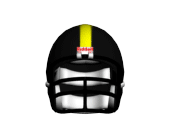Pittsburgh Steelers Team History
 The
Pittsburgh Steelers were founded by Arthur J. Rooney on July
8, 1933. Now the sixth-oldest franchise in the NFL, the Pittsburgh
team was known as the Pirates until 1940. The Steelers struggled
for their first 40 years without winning a championship of any
kind until they won the AFC Central division title in 1972.
Two years later, the entire sports world cheered when Art Rooney,
one of world's most popular sports figures, received the Vince
Lombardi Trophy after the Steelers' victory in Super Bowl IX. The
Pittsburgh Steelers were founded by Arthur J. Rooney on July
8, 1933. Now the sixth-oldest franchise in the NFL, the Pittsburgh
team was known as the Pirates until 1940. The Steelers struggled
for their first 40 years without winning a championship of any
kind until they won the AFC Central division title in 1972.
Two years later, the entire sports world cheered when Art Rooney,
one of world's most popular sports figures, received the Vince
Lombardi Trophy after the Steelers' victory in Super Bowl IX.
After so many years of frustration, the 1970s Steelers began
one of the most incredible streaks in sports history when they
earned eight consecutive playoff berths, seven AFC Central titles
and four AFC championships from 1972 to 1979. The Steelers became
the first team to win four Super Bowls and the only team to
win back-to-back Super Bowls twice. The team of the decade of
the 1970s became the first AFC team to win its division 10 times
since the NFL's 1970 merger.
The list of Pittsburgh Steelers heroes of the 1970s is long
but it begins with Head Coach Chuck Noll, who took control of
the team in 1969. Such stars as defensive tackle Joe Greene,
linebackers Jack Ham and Jack Lambert, quarterback Terry Bradshaw,
cornerback Mel Blount and running back Franco Harris were the
backbone of a team that many insist was the finest ever in pro
football. All, including Noll, were accorded membership in the
Pro Football Hall of Fame in their first years of eligibility.
Pittsburgh's success in the last two decades is the antithesis
of the Steelers' experiences in their early years. The Pittsburgh
eleven won only 22 games its first seven seasons. Rooney, seeking
a way to make ends meet, often took his team from Forbes Field
to such neutral cities as Johnstown and Latrobe in Pennsylvania,
Youngstown, Louisville and New Orleans so as to avoid competition
with baseball and college football in Pittsburgh. Through it
all, Rooney never wavered in his determination to make pro football
successful in his city.
In 1938, Rooney made Colorado All-America Byron "Whizzer"
White the NFL's first "big money" player with a $15,800
contract. The 1942 Steelers, boosted by the NFL-leading rushing
of rookie Bill Dudley, enjoyed their first winning season. With
rosters depleted by the manpower shortage of World War II, Rooney
merged the Steelers with the Eagles (Phil-Pitt) in 1943 and
the Cardinals (Card-Pitt) in 1944. Coach Jock Sutherland led
the Steelers to a first-place tie with the Philadelphia Eagles
in 1947 but they lost their first post-season game ever to the
Eagles, 21-0.
From 1957 to 1963, the Steelers, coached by Buddy Parker and
with quarterback Bobby Layne, defensive tackle Ernie Stautner
and running back John Henry Johnson playing key roles, were
legitimate divisional championship contenders. But the "dynasty
years" that coincided with the move to the AFC at the time
of AFL-NFL merger, forever brightening Pittsburgh Steelers history,
were still a decade away. |